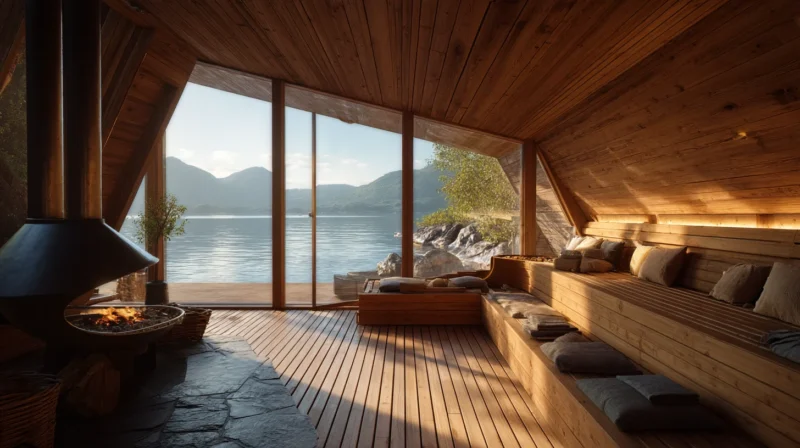In this article:
- Designing for Stillness
- Materials That Breathe
- Light, Space, and the Psychology of Quiet
- Retreat as Creative Ritual
- Conclusion
In a world saturated with pings, scrolls, and the subtle demand to stay constantly connected, creatives are beginning to reconsider what it means to really unplug. Disconnection is no longer a luxury—it’s becoming a design imperative. Spaces that offer stillness, solitude, and simplicity are gaining new significance, not just as homes but as environments that support clarity, focus, and intentional living.
From cabins tucked into the treeline to compact, design-forward park model homes built for intention over indulgence, the architecture of retreat is shifting. These aren’t rustic getaways in the nostalgic sense—they’re curated environments shaped by clean lines, restrained materials, and a visual quietude that encourages clarity. For the creative mind, stepping away doesn’t have to be dramatic. Sometimes, it simply means entering a space designed to slow everything down.
Designing for Stillness
Spaces that support disconnection tend to share essential traits: simplicity, material honesty, and spatial restraint. They strip away the excess not to create emptiness, but to cultivate a quiet atmosphere where the mind can settle. For many creatives, that clarity becomes the spark for fresh ideas.
Structures like park model homes reflect this design philosophy. With efficient footprints and high attention to form, these dwellings prioritize function without sacrificing beauty. Whether used as weekend retreats, studios, or primary homes, they foster a lifestyle that encourages slowing down and tuning in.
Instead of competing for attention, the best spaces offer a visual pause. Wood textures, natural light, and minimal ornamentation aren’t just aesthetic choices; they become part of the atmosphere. When design is reduced to its essentials, the space becomes more than functional. It becomes a refuge.
Materials That Breathe
The sensory quality of a space has a lasting effect on how we feel. In environments designed for quiet living, materials do more than provide structure—they set the tone. Unfinished wood, raw linen, poured concrete, matte black fixtures: each contributes to a tactile vocabulary that soothes instead of stimulates.
Designers working on retreat-style spaces often prioritize this kind of material authenticity. The goal isn’t nostalgia. It’s groundedness. When you touch a solid wood surface, you’re connecting with something textured, permanent, and real—qualities that mass-produced materials rarely deliver.

Get 300+ Fonts for FREE
Enter your email to download our 100% free "Font Lover's Bundle". For commercial & personal use. No royalties. No fees. No attribution. 100% free to use anywhere.
This material logic is especially visible in small dwellings and cabins. With limited square footage, every surface becomes part of the emotional architecture. Thoughtful choices have to do more. The result is a home that doesn’t just look intentional—it feels it.
Light, Space, and the Psychology of Quiet
Spatial design is as much about atmosphere as it is about layout. In environments meant to interrupt the noise of modern life, light becomes a core material. Natural light, in particular, significantly changes the mood of a space. It softens edges, marks time, and builds rhythm in a way artificial lighting rarely can.
Designing for quiet means reducing visual noise: less clutter, more open sightlines, a clearer hierarchy of form. Park model homes and similar small-scale dwellings often adopt this naturally. Their compact size demands restraint—fewer furnishings, better flow, more connection to the outdoors.
Architects and designers are increasingly informed by environmental psychology when shaping spaces like these. As Illustrarch explains, natural light, open layouts, and honest materials can reduce sensory overload and support emotional balance. For creatives, that can mean more than calm—it can mean clarity.
Retreat as Creative Ritual
For many creatives, a retreat isn’t about luxury. It’s about returning to rhythm. A well-designed space becomes a tool for focus, allowing its occupant to step away from the clutter of daily life and into something quieter, more intentional.
These retreats are rarely elaborate. Often, they’re modest in scale—a compact cabin, a converted outbuilding, or a small studio home tucked into a quiet backdrop. Their power lies in how little they demand. The simplicity of the design invites a sense of presence. And in that space, it becomes easier to listen—both to the environment and to yourself.
This return to scaled-back environments mirrors a broader design mindset: make less, but make it count. You can see the same thinking in many curated visual resources focused on minimalism and creative discipline, where every choice is considered, and nothing is decorative without purpose. In this way, a modern retreat isn’t a form of escape. It’s a focused expression of intent.
Conclusion
Designing for disconnection isn’t about retreating from life; it’s about embracing a new perspective. It’s about creating space for it. In a culture built around constant access, stillness has become a design value in its own right. Whether it’s a compact home in the woods or a stripped-back studio on the edge of town, the aesthetics of escape offer more than relief—they offer a shift in perspective.
For creatives, these spaces do more than support better living—they influence how we think, what we create, and how deeply we can focus. As more designers adopt smaller, smarter, and more intentional approaches to building, these quiet, purpose-driven environments may evolve into something more enduring: a new model for living and working with clarity.




